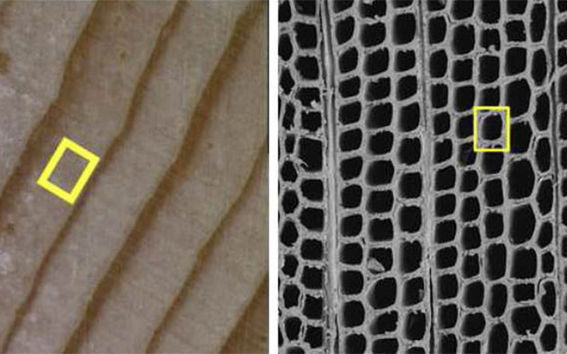Modelling helps investigate the properties of wood

Johanna Sjölund's doctoral dissertation presents a model for computing the rigidity of spruce at any location in the growth ring using selected parameters. The dissertation also presents methods that facilitate the development of previously published models.
Researchers are interested in the properties of wood because wood is used in a variety of applications including construction and the manufacturing of paper, furniture and packaging.
‘Wood has a complex structure. Modelling provides us with a good idea of how individual properties, such as the geometry of cells and the thickness of cell walls, affect the rigidity of wood’, Sjölund says.
If a model is good enough, it can be used to replace laborious and time-consuming physical experiments. By using modelling, researchers can examine how individual structural properties and their variation affect the behaviour of wood.
‘One of the facts revealed through modelling is that the shape of wood cells has a significantly greater impact on rigidity than was previously assumed’, Sjölund says.
Wood is an environmentally friendly material with good mechanical properties. This makes it a popular material, which also increases the interest in modelling. Modelling has also become easier as the computational performance of computers has improved.
‘Perhaps one day we will have a computational model that can be used to accurately assess the bearing capacity and properties of wood in various structures. This would help designers use the correct amount of wood in their structures and save material. Modelling could also be used to improve the energy efficiency of pulp manufacturing’, Sjölund envisions.
Duplicating one cell
The dissertation revealed that variation in cell wall thickness had a significantly greater effect on the rigidity of spruce than variation in cell shape. This is why Sjölund decided to omit shape variation from her model.
‘Omitting unessential parameters enables you to focus on the essential parameters and on carefully modelling their effects. Using fewer parameters also decreases the time needed to perform the computation.’
Leaving out the variation in cell shape enabled Sjölund to base her modelling on one cell representing an infinite number of cells.
Basing the modelling on one cell further decreased the time needed to perform the computation. This meant that the nine parameters related to the orthotropic nature of wood could be included in the model. The orthotropicity of wood means that the properties of cell walls are different along different axes.
Sjölund ensured the functionality of her model using cell-structured Nomex, a material used in the automotive and aviation industry.
Johanna Sjölund defended her doctoral dissertation on 24 April 2015 at the Aalto University School of Engineering's Department of Applied Mechanics. The title of her dissertation is Effect of cell structure geometric and elastic parameters on wood rigidity.
Web address for the dissertation: https://aaltodoc.aalto.fi/handle/123456789/49
Further information:
Johanna Sjölund
Tel. +358 44 2704 670, [email protected]
- Published:
- Updated:
Read more news

Get to know us: Associate Professor Maria Sammalkorpi
Sammalkorpi received her doctorate from Helsinki University of Technology 2004. After her defence, she has worked as a researcher at the Universities of Princeton, Yale and Aalto.
Aalto computer scientists in ICML 2024
Computer scientists in ICML 2024
Getting bacteria into line
Physicists use magnetic fields to manipulate bacterial behaviour